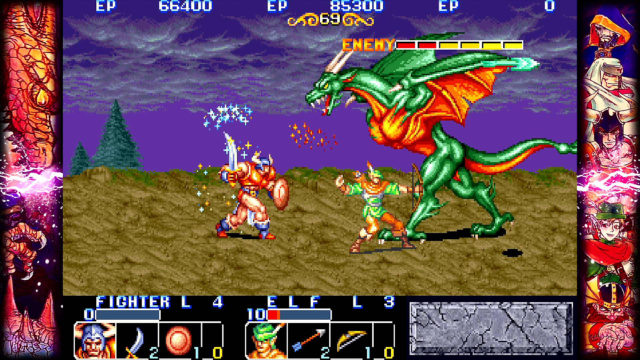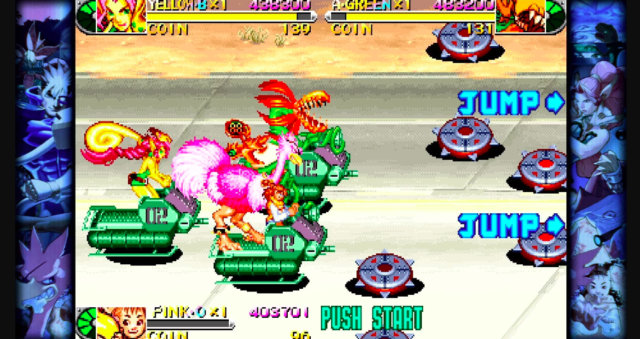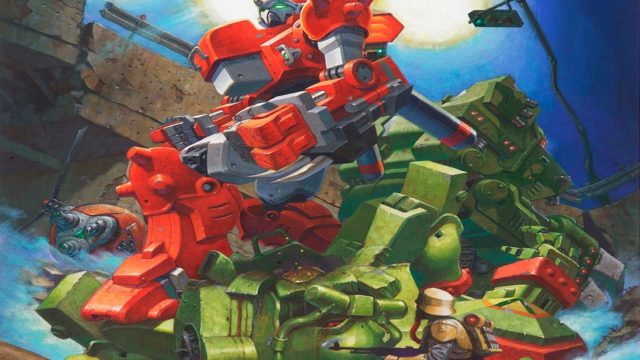Some of the best brawlers ever made in a single game; delightful visuals; gallery mode provides a wonderful bit of history; tons of replay value; multiplayer; save states
Online multiplayer is rough; some might bemoan the inability to customize the visuals for a more authentic retro look
Side-scrolling brawlers might have a bad rep these days, but 2D beat ’em ups have been a mainstay of the video game industry for many, many years, serving as a precursor to the fighting game genre as fans know it. Up until the release of Street Fighter II, brawlers ruled the arcades. One developer that truly pushed the genre in some fun, unique directions was Capcom. Series like Final Fight really set the standard for brawlers all the way to today, while more experimental fare such as Armored Warriors played around with the formula by introducing new mechanics. With the release of Capcom Beat ‘Em Up Bundle, fans can download those games alongside five other classic brawlers. It’s a delightful mix of titles that, combined with excellent production values, online features, and a solid (albeit truncated) art gallery, make this a can’t-miss collection.
The following games are all included in Capcom Beat ‘Em Up Bundle:
- Final Fight (1989)
- Captain Commando (1991)
- The King of Dragons (1991)
- Knights of the Round (1991)
- Warriors of Fate (1992)
- Armored Warriors (1994)
- Battle Circuit (1997)
All seven titles come boasting a number of benefits as part of Beat ‘Em Up Bundle. This includes high definition graphic upscaling, save states, unlimited continues (or “Free Play” as it’s called in arcades!), adjustable difficulty levels, customizable point thresholds for earning extra lives, and online play. The presentation here is great, although it is a bit odd that Capcom chose to completely omit any sort of screen customization. Players can’t add scan lines or mess around with the aspect ratio as has become commonplace in retro re-releases like M2’s new Sega Ages titles, for instance. It’s not much of a loss, honestly, as the visuals are bold and beautiful as-is. Not being able to tinker with them is truly immaterial. For those desperate for some form of personalization, there is the option to add a variety of wallpapers, which are basically just border images that sit to the left and right of the on-screen action. I personally find them distracting and shut them off, but many fans will enjoy their inclusion and the variety of images on offer.
One thing to consider when playing any game that was originally made for release in arcades is that the goal by the design team was to get people to keep paying to play. That’s a lot different than making a home console game where the objective is typically to get people to keep playing for the sake of playing. As such, it isn’t uncommon to come across crushingly difficult arcade titles, where the challenge is set ridiculously high in part just to pull more quarters from a player’s pockets. I mention this because, as I pointed out above, Beat ‘Em Up Bundle allows players to save anywhere, adjust the difficulty level, and make it easier to get extra lives in every title. That might sound like it diminishes some of the fun or challenge of these games, but in reality I found it to be a nice way of balancing things out. Plus, while the games might be in “Free Play” mode, players are free to quit or restart at any time if they don’t want to “spam” or abuse the limitless continues.

Every title in Beat ‘Em Up Bundle has an image gallery for fans to scroll through. I revel in this sort of minutiae, as it offers a priceless glimpse into both the development of a game as well as its promotion. Arcade games, in particular, were often treated like cash cows and nothing more, as their existence was (and still is) solely to produce lines of people perpetually plugging tokens and quarters into each machine. Sure, people have to be having fun for that to happen, but ultimately making money was the end goal. So, it’s all the more rewarding to be able to look into the pieces of art that are part of the history of these workhorse pieces of software. I only regret that Capcom didn’t include even more of it, or perhaps even some anecdotes or other details pertaining to each game. Maybe if the physical release of Beat ‘Em Up Bundle ever comes to North America Capcom can throw in an artbook!
A lot of the games here will be a known commodity to most fans, but some of them likely won’t be. Final Fight is arguably the most well-known of the bunch. It’s the prototypical brawler, second only, debatably, to Sega’s Streets of Rage 2. There’s a simplicity (or perhaps purity is a better word) to Final Fight that makes it the most approachable of the septet of titles. There are plenty of cool moves to pull off, not to mention different play styles thanks to the roster of characters, regardless of the more basic mechanics. It’s a perfect starting point for people new to the genre. Captain Commando has most of Final Fight‘s DNA in it, but expands upon that game with a sci-fi setting and crazier moves and weapons to utilize. Along with more settings to enjoy, Captain Commando does a lot to push things forward while still remaining accessible.

The trio of fantasy-based games in Beat ‘Em Up Bundle vary in terms of quality. The middle-ranking entry of the bunch is The King of Dragons. It incorporates some RPG mechanics into the proceedings along with magic and fighters whose move sets complement one another (one is slow but can heal, the other is powerful but can’t heal, etc.), but suffers from average combat mechanics. Knights of the Round, meanwhile, also has pedestrian combat, even more so than The King of Dragons, but doesn’t compensate for it with additional mechanics to help boost the gameplay. There’s horse riding and an interesting blocking system but, overall, Knights of the Round comes up short. The better of these three games is Warriors of Fate. It’s a title most western fans will likely be the least familiar with, but it offers immersive and complex combat, and a big roster of characters to select from.
Rounding things out are two arcade games that have never been on a home console before: Armored Warriors and Battle Circuit. I had never played either of these two titles prior, and I really, really liked both. Dropping in 1997, Battle Circuit is the last arcade brawler Capcom produced (and was also never released in the US). It benefits from Capcom’s years of experience with the genre, as it has some of the best visuals of all the games here, as well as fun additions to the beat ’em up recipe in the form of unlockable fight moves and buffs for each character. My favorite of these two games, however, was Armored Warriors. It’s a brawler with mechs! Giant sprites, destructible environs, and the ability to augment the player’s selected mech with pieces harvested from foes in the heat of battle. It’s a real gem of a title and reason enough for the entire collection to exist, frankly.

Beat ‘Em Up Bundle is comprised of titles that were made to be played with multiple people, something that is still the case today. Gathering a group of friends into one room to play everything from Captain Commando to Battle Circuit is a breeze and a joy thanks to the nature of Switch’s Joy-Con controllers. While playing on the small screen of Switch in Tabletop Mode might not sound appealing, it works surprisingly well (although a TV is still the best option). Online play, sadly, is laggy and flawed at this point. Whether a patch down the road will help remains to be seen, but it’s the only real blemish to speak of in regards to Beat ‘Em Up Bundle. This isn’t just a historically significant assemblage of games, it’s also an immensely fun one. Fans of the genre and those new to it should definitely consider giving it a download, particularly for the games that are appearing on home console for the first time.
Nintendojo was provided a copy of this game for review by a third party, though that does not affect our recommendation. For every review, Nintendojo uses a standard criteria.




 ShareThis
ShareThis





